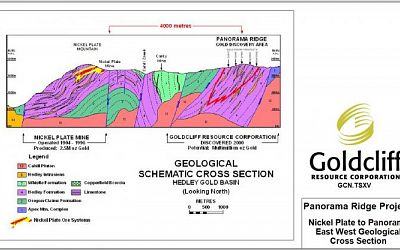Property Description/Geology
Regional Geology
The Hedley Gold Basin is located within the Intermontane Belt of the Canadian Cordillera and is comprised of Paleozoic to Jurassic volcanic and sedimentary rocks that have been intruded by a series of stocks, plutons and batholiths. The Hedley Gold Basin trends in a northeast to southwest direction for 35 kilometres and in a northwest to southeast direction for 15 kilometres. The Hedley Gold Basin is geographically subdivided by the Similkameen River Valley (northwest-southeast trending valley)into a northern portion, Hedley Gold Basin North, (Nickel Plate mining district) and a southern portion, Hedley Basin South (Sterling Creek mining district). The Hedley Gold Basin North contains the Nickel Plate mine and all the other former gold skarn producers (Mascot Fraction, Canty, Good Hope, French). The Hedley Gold Basin South contains identical geology to Hedley Gold Basin North with minor gold production from quartz veins at Banbury mine (Maple Leaf and Pine Knot veins).
The gold deposits and occurrences in the Hedley Gold Basin are spatially associated with dioritic bodies of the Hedley intrusions and the gold mineralization is broadly classified as skarn-related or vein-related. The most receptive host rocks for gold mineralization are the Nicola Group. Within the Nicola Group, the host rocks for skarn-related gold are stratigraphically situated within the calcareous siltstones, gritty impure limestones and calcareous tuffs that occur below and above the Copperfield breccia. For vein-related gold, the structural preparation of the Nicola Group rocks provides the ideal gold emplacement environment anywhere in the stratigraphic sequence.
The skarn-related gold mineralization is characterized by the gold being intimately associated with variable quantities of sulphide bearing garnet-pyroxene-carbonate skarn alteration. The gold tends to be associated with sulphides, particularly arsenopyrite, pyrrhotite and chalcopyrite, and in lesser amounts with pyrite, gersdorffite (NiAsS), sphalerite, magnetite and cobalt minerals. Trace minerals include galena, native bismuth,electrum, tetrahedrite and molybdenite. The pathfinder elements are Ag, As, Bi, Co, Cr, Ni, Cu, Mo, Pb, Sb and Zn. This type of mineralization is found at the Nickel Plate, French, Good Hope, Peggy and Canty deposits as well as the York, Nordic and Spar prospects. The skarn alteration occurs associated with stratabound, layered massive sulphides and with disseminated sulphides within host environments.
Property Geology
The Panorama Ridge property geology is mainly taken from Ray et al, (1994) with additions from Placer Development Limited (1985) and Goldcliff Resource Corporation (2001). The oldest rocks on the Panorama Ridge property are the on the north eastern margin of claims and belong to the Paleozoic Apex Mountain Complex. The Apex Mountain Complex consists of a deformed package of chert, argillite, greenstone, tuffaceous siltstone and minor limestone that form the basement of the Hedley Gold Basin. These rocks are not considered favourable hosts for gold skarn mineralisation. The rocks on the Panorama Ridge property that are the favourable host rocks for gold skarn mineralization are the Late Triassic Nicola Group. The oldest of the Nicola Group rocks belong to the Oregon Claims Formation which outcrop along the western boundary of the claims. This formation is composed of basaltic ash tuff and minor basaltic tuff. A few outcrops of lapilli tuff were noted along the West Cahill Road in the footwall of a major shear zone. This fault may mark a contact with younger Nicola Group rocks to the east.
The detailed area of interest (York-Nordic-Spar-Epic area) consists of rocks of the Hedley Formation and the Whistle Formation. The Hedley Formation consists of greenish siliceous siltstone and minor argillite that has been altered to a calc-silicate (diopside) skarn and/or a chlorite alteration. The rocks are strongly impregnated with disseminated iron sulphides of pyrrhotite and pyrite. The Whistle Formation consists of argillaceous/ash tuff with siltstone. These rocks are a medium to dark green grey colour due to calc-silicate (diopside) skarn alteration and are strongly impregnated with disseminated iron sulphides of pyrrhotite and pyrite. Due to the skarn alteration and sulphide impregnation of these two rock units, the identification of the two formations is difficult.
The characteristic rock unit that distinguishes the Hedley Formation (sediments) from the Whistle Formation (volcanics) is the Copperfield breccia. The Copperfield breccia is the basil unit of the Whistle Formation and a important gold skarn mineralization stratigraphic marker. Large boulders of Copperfield breccia have been found along the crest of Panorama Ridge that separates the York and Nordic prospects. The Copperfield breccia is characterized by limestone fragments and large limestone boulders and is a very significant unit separating the volcanic rocks (Whistle Formation) from sedimentary rocks (Hedley Formation) in the Hedley Gold Basin. This interface is an important geological event for gold skarn mineralization. The Copperfield breccia is the marker unit that represents the period of calcareous interfacing (limestone) between sediments and volcanics. This interface defines where gold skarn mineralisation will occur within the Hedley Gold Basin.
Seven gold skarn prospects have been identified on the northern portion of the Panorama Ridge property (Nordic, Winters, Spar, York, Slope, Chill and Skar). The gold skarn mineralisation is characterised as disseminated or strata-bound. The disseminated gold skarn mineralisation is fracture related and/or pervasive in association with cal-silicate alteration and abundant sulphides of pyrrhotite and pyrite. All the prospects contain this type of gold skarn mineralization. The strata-bound gold skarn mineralisation is associated with massive layered pyrrhotite and pyrite containing garnet, pyroxene and epidote skarn alteration. This type of mineralisation has been identified at the York and Winters prospects.



